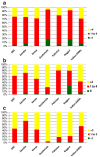Home birth attendants in low income countries: who are they and what do they do?
- PMID: 22583622
- PMCID: PMC3493311
- DOI: 10.1186/1471-2393-12-34
Home birth attendants in low income countries: who are they and what do they do?
Abstract
Background: Nearly half the world's babies are born at home. We sought to evaluate the training, knowledge, skills, and access to medical equipment and testing for home birth attendants across 7 international sites.
Methods: Face-to-face interviews were done by trained interviewers to assess level of training, knowledge and practices regarding care during the antenatal, intrapartum and postpartum periods. The survey was administered to a sample of birth attendants conducting home or out-of-facility deliveries in 7 sites in 6 countries (India, Pakistan, Guatemala, Democratic Republic of the Congo, Kenya and Zambia).
Results: A total of 1226 home birth attendants were surveyed. Less than half the birth attendants were literate. Eighty percent had one month or less of formal training. Most home birth attendants did not have basic equipment (e.g., blood pressure apparatus, stethoscope, infant bag and mask manual resuscitator). Reporting of births and maternal and neonatal deaths to government agencies was low. Indian auxilliary nurse midwives, who perform some home but mainly clinic births, were far better trained and differed in many characteristics from the birth attendants who only performed deliveries at home.
Conclusions: Home birth attendants in low-income countries were often illiterate, could not read numbers and had little formal training. Most had few of the skills or access to tests, medications and equipment that are necessary to reduce maternal, fetal or neonatal mortality.
Figures
Similar articles
-
Knowledge, attitudes and practices of traditional birth attendants in pastoralist communities of Laikipia and Samburu counties, Kenya: a cross-sectional survey.Pan Afr Med J. 2016 Nov 26;25(Suppl 2):13. doi: 10.11604/pamj.supp.2016.25.2.9983. eCollection 2016. Pan Afr Med J. 2016. PMID: 28439337 Free PMC article.
-
Effect of home-based neonatal care and management of sepsis on neonatal mortality: field trial in rural India.Lancet. 1999 Dec 4;354(9194):1955-61. doi: 10.1016/S0140-6736(99)03046-9. Lancet. 1999. PMID: 10622298
-
Reduced perinatal mortality following enhanced training of birth attendants in the Democratic Republic of Congo: a time-dependent effect.BMC Med. 2011 Aug 4;9:93. doi: 10.1186/1741-7015-9-93. BMC Med. 2011. PMID: 21816050 Free PMC article. Clinical Trial.
-
Review of educational interventions to increase traditional birth attendants' neonatal resuscitation self-efficacy.Women Birth. 2019 Feb;32(1):16-27. doi: 10.1016/j.wombi.2018.04.016. Epub 2018 May 21. Women Birth. 2019. PMID: 29793845 Review.
-
Reduction of maternal and perinatal mortality in rural and peri-urban settings: what works?Eur J Obstet Gynecol Reprod Biol. 1996 Oct;69(1):47-53. doi: 10.1016/0301-2115(95)02535-9. Eur J Obstet Gynecol Reprod Biol. 1996. PMID: 8909956 Review.
Cited by
-
Global network for women's and children's health research: a system for low-resource areas to determine probable causes of stillbirth, neonatal, and maternal death.Matern Health Neonatol Perinatol. 2015 May 4;1:11. doi: 10.1186/s40748-015-0012-7. eCollection 2015. Matern Health Neonatol Perinatol. 2015. PMID: 27057328 Free PMC article.
-
Improving maternal and newborn care: cost-effectiveness of an innovation to rebrand traditional birth attendants in Sierra Leone.Int J Public Health. 2020 Dec;65(9):1603-1612. doi: 10.1007/s00038-020-01487-z. Epub 2020 Oct 10. Int J Public Health. 2020. PMID: 33037894 Free PMC article.
-
Adapted Helping Babies Breathe approach to neonatal resuscitation in Haiti: a retrospective cohort study.BMC Pediatr. 2022 Jan 3;22(1):7. doi: 10.1186/s12887-021-02987-4. BMC Pediatr. 2022. PMID: 34980010 Free PMC article.
-
Rates and determinants of early initiation of breastfeeding and exclusive breast feeding at 42 days postnatal in six low and middle-income countries: A prospective cohort study.Reprod Health. 2015;12 Suppl 2(Suppl 2):S10. doi: 10.1186/1742-4755-12-S2-S10. Epub 2015 Jun 8. Reprod Health. 2015. PMID: 26063291 Free PMC article.
-
Self-reported practices among traditional birth attendants surveyed in western Kenya: a descriptive study.BMC Pregnancy Childbirth. 2016 Aug 12;16(1):219. doi: 10.1186/s12884-016-1007-8. BMC Pregnancy Childbirth. 2016. PMID: 27514379 Free PMC article.
References
-
- Lawn JE, Haws RA, Darmstadt GL, Yakoob MY, Menezes EV, Soomro T, Bhutta ZA. 3.2 million stillbirths: Epidemiology and framework for evaluation of interventions to prevent stillbirths in low and middle income settings. BMC Pregnancy and Childbirth. 2009;9(Suppl 1):S2. doi: 10.1186/1471-2393-9-S1-S2. - DOI - PMC - PubMed
-
- Fatmi Z, Gulzar AZ, Kazi A. Maternal and Newborn care: practices and beliefs of traditional birth attendants in Sindh, Pakistan. East Mediterranean Health Journal. 2005 Jan - Mar;11(1-2):226-–34. - PubMed
Publication types
MeSH terms
Grants and funding
LinkOut - more resources
Full Text Sources



